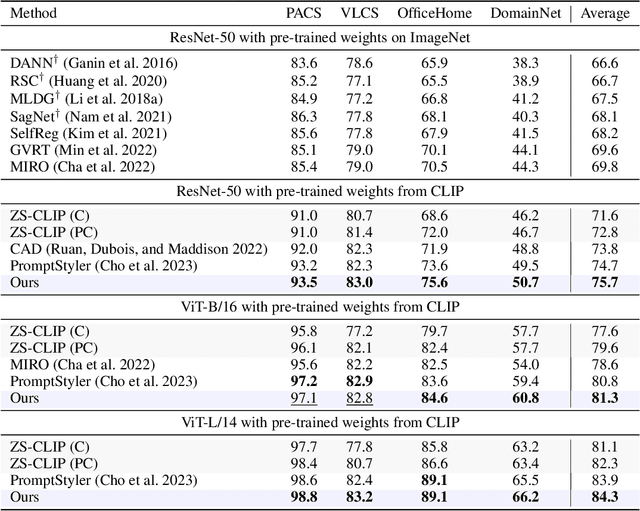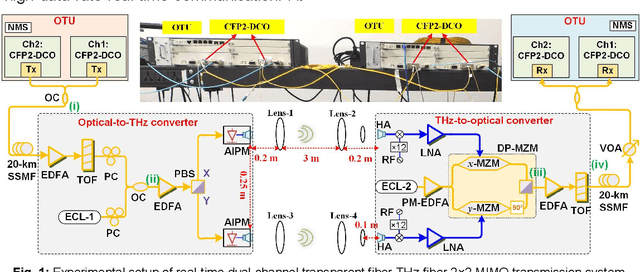Jiao Zhang
StylePrompter: Enhancing Domain Generalization with Test-Time Style Priors
Aug 17, 2024



Abstract:In real-world applications, the sample distribution at the inference stage often differs from the one at the training stage, causing performance degradation of trained deep models. The research on domain generalization (DG) aims to develop robust algorithms that can improve the generalized performance in unseen domains by training on a few domains. However, the domain-agnostic vision model, trained on a limited number of domains using traditional domain generalization methods, cannot guarantee its effectiveness in dealing with unseen domains. The introduction of language can break the closed cognition space of the vision model, providing additional semantic information that cannot be inferred from vision-only datasets. In this paper, we propose to overcome the challenge in previous DG methods by introducing the style prompt in the language modality to adapt the trained model dynamically. In particular, we train a style prompter to extract style information of the current image into an embedding in the token embedding space and place it in front of the candidate category words as prior knowledge to prompt the model. Our open space partition of the style token embedding space and the hand-crafted style regularization enable the trained style prompter to handle data from unknown domains effectively. Extensive experiments verify the effectiveness of our method and demonstrate state-of-the-art performances on multiple public datasets. Codes will be available after the acceptance of this paper.
Towards Reliable Domain Generalization: A New Dataset and Evaluations
Sep 12, 2023Abstract:There are ubiquitous distribution shifts in the real world. However, deep neural networks (DNNs) are easily biased towards the training set, which causes severe performance degradation when they receive out-of-distribution data. Many methods are studied to train models that generalize under various distribution shifts in the literature of domain generalization (DG). However, the recent DomainBed and WILDS benchmarks challenged the effectiveness of these methods. Aiming at the problems in the existing research, we propose a new domain generalization task for handwritten Chinese character recognition (HCCR) to enrich the application scenarios of DG method research. We evaluate eighteen DG methods on the proposed PaHCC (Printed and Handwritten Chinese Characters) dataset and show that the performance of existing methods on this dataset is still unsatisfactory. Besides, under a designed dynamic DG setting, we reveal more properties of DG methods and argue that only the leave-one-domain-out protocol is unreliable. We advocate that researchers in the DG community refer to dynamic performance of methods for more comprehensive and reliable evaluation. Our dataset and evaluations bring new perspectives to the community for more substantial progress. We will make our dataset public with the article published to facilitate the study of domain generalization.
A Scalable Arrangement Method for Aperiodic Array Antennas to Reduce Peak Sidelobe Level
Jul 04, 2023Abstract:Peak sidelobe level reduction (PSLR) is crucial in the application of large-scale array antenna, which directly determines the radiation performance of array antenna. We study the PSLR of subarray level aperiodic arrays and propose three array structures: dislocated subarrays with uniform elements (DSUE), uniform subarrays with random elements (USRE), dislocated subarrays with random elements (DSRE). To optimize the dislocation position of subarrays and random position of elements, the improved Bat algorithm (IBA) is applied. To draw the comparison of PSLR effect among these three array structures, we take three size of array antennas from small to large as examples to simulate and calculate the redundancy and peak sidelobe level (PSLL) of them. The results show that DSRE is the optimal array structure by analyzing the dislocation distance of subarray, scanning angle and applicable frequency. The proposed design method is a universal and scalable method, which is of great application value to the design of large-scale aperiodic array antenna.
Real-time Dual-channel 2 * 2 MIMO Fiber-THz-Fiber Seamless Integration System at 385 GHz and 435 GHz
Jun 24, 2022



Abstract:We demonstrate the first practical real-time dual-channel fiber-THz-fiber 2 * 2 MIMO seamless integration system with a record net data rate of 2 * 103.125 Gb/s at 385 GHz and 435 GHz over two spans of 20 km SSMF and 3 m wireless link.
 Add to Chrome
Add to Chrome Add to Firefox
Add to Firefox Add to Edge
Add to Edge